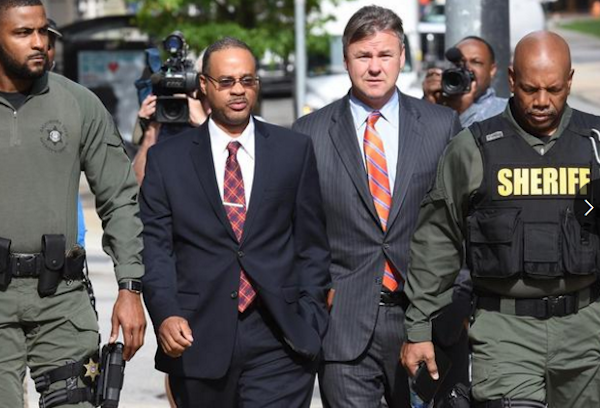VERDICT WATCH: Freddie Gray: Trial of Van Driver Officer Caesar Goodson

Thursday morning trial Judge Barry Williams is expected to release his bench verdict in the “Freddie Gray” trial of van driver Officer Caesar Goodson. Officer Goodson is charged with murder, multiple counts of manslaughter, second-degree assault, misconduct in office and reckless endangerment.
Goodson is the third of six charged officers to be tried in the death of Freddie Gray while in police custody. The jury trial of Officer William Porter ended in a hung jury, and Porter is scheduled to be re-tried. The bench trial of Officer Edward Nero ended in an acquittal. As was the case with Nero, Goodson also elected to have a bench trial.
The prosecution in all these cases has put forth three distinct theories of criminal liability for the charged officers: (1) Murder by failure to seatbelt; (2) Murder by failure to provide prompt medical care; (3) Murder by “rough ride.”
In the trial of Officer Goodson it appears that the State had planned to wield the “Murder by failure to provide prompt medical care” in seeking a conviction. On the day of trial, however, evidence previously concealed by the prosecution was revealed which seriously undermined that theory of the case.
As a result, literally just before the prosecution had to deliver their opening statement in this trial, they felt compelled to change horses to the third legal theory of the case, “Murder by ‘rough ride’.” That is, that van driver Goodson had deliberately subjected the vehicle transporting Freddie Gray to sudden changes in direction and speed with the intent of subjecting Gray to injury.
Indeed, the Chief Deputy State’s Attorney Michael Schatzow’s opening statement focused almost entirely on this “rough ride” theory.
Over the course of the actual trial, however, it became apparent that the prosecutors did not possess any evidence that a “rough ride” had actually occurred. I feel obliged to repeat this: the prosecution was unable to present any evidence that a “rough ride” had actually occurred.
Laughably, what evidence on the “rough ride” issue was presented in court actually contraindicated a rough ride.
Donte Allen, who rode in the same van during the last leg of Gray’s transport, would tell investigators that same day that the van ride was “smooth,” with no conduct by Goodson even suggestive of a rough ride.
Numerous security videos along the van’s route captured its progress, yet none showed any sudden stops or movements. The prosecution argued that Goodson’s failure to come to a complete stop at a stop sign and his crossing the center line in taking a wide right-hand turned was sufficient to support a conviction of murder. In fact, both these actions by Goodson would subject Gray to fewer, not more, centrifugal forces than if Goodson had come to a complete stop or taken a sharper turn.
No witness was found who was willing to testify that the van was driven in a manner consistent with a rough ride.
Even the prosecution’s own purported expert witness on “rough rides” was compelled to concede on the witness stand that he had no personal knowledge nor any basis on which to form an expert opinion that Goodson subjected Gray to a rough ride.
Indeed, so lacking in foundation was the “Murder by ‘rough ride’” theory of the case by the time of closing arguments, that prosecutor Jan Bledsoe made no mention of it whatever in the state’s initial close. That’s right: the legal theory that had totally dominated the prosecution’s opening statement a few days earlier had been completely memory-holed. Instead, Bledsoe argued the prosecution’s two alternative theories of the case: “Murder by failure to seatbelt” and “Murder by failure to provide prompt medical care.”
This discrepancy was, as one might imagine, emphasized by the defense in their own closing arguments. The Associated Press reports that defense attorney Matthew Fraling referred to the prosecution’s changing theory-of-the-day as a game of “Three Card Monty”:
The state came into this matter on the proverbial high horse of a ‘rough ride. They have failed to cobble together any type of case with reasonable inferences, let alone evidence.
And the Baltimore Sun reports Fraling as stating:
Once it was identified there was no rough ride, now it’s time to quickly reshuffle the cards.
After Fraling’s close, prosecutor Schatzow was given the opportunity to rebut, and found himself the subject of some sharp questioning by Judge Williams:
The state brought [“murder by seatbelt”] into the world. You’re the one who said it [in your opening argument]. What did you show?
According to reporting by the Baltimore Sun, Judge Williams also asked Schatzow whether it wasn’t the case that the evidence was equally consistent with a theory of accident as with a “rough ride.”
Williams also expressed skepticism about whether the evidence supported the “murder by failure to provide prompt medical care” theory of the case, asking the prosecutor if Goodson’s conduct would still have been criminal had it turned out that Gray had not actually been seriously injured.
Because Goodson elected a bench rather than a jury trial, Judge Williams serves as both the finder of law and the finder of fact in this case, and he rather than a jury will arrive at a verdict. A precise time for the release of Judge Williams’ verdict has not been provided by the court, but you can expect us to publish the verdict promptly as soon as it is released.
–-Andrew, @LawSelfDefense
Attorney Andrew Branca and his firm Law of Self Defense have been providing internationally-recognized expertise in American self-defense law for almost 20 years in the form of books, live seminars & online training (both accredited for CLE), public speaking engagements, and individualized legal consultation.
“Law of Self Defense, 3rd Ed.” /Seminars / Instructor Program / Twitter /Facebook / Youtube
[Featured Image Source: Baltimore Sun]
CLICK HERE FOR FULL VERSION OF THIS STORY